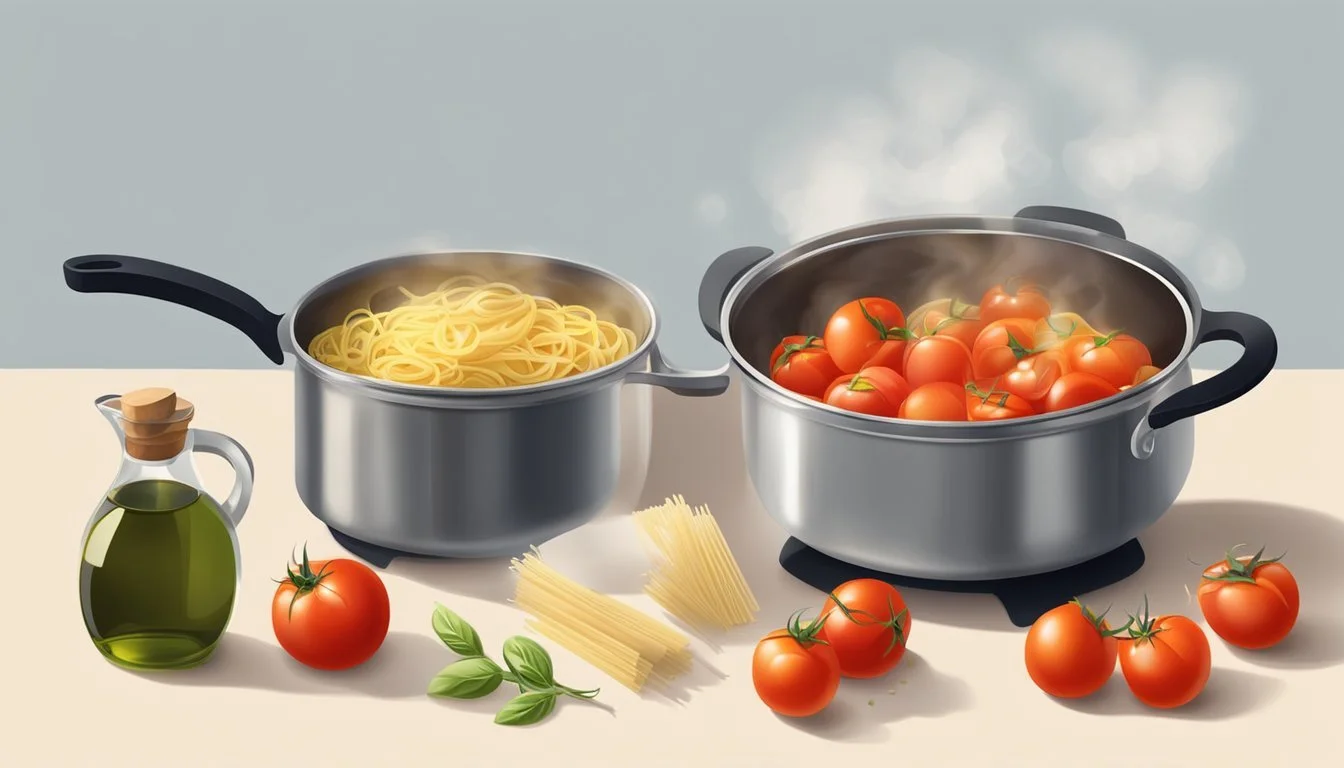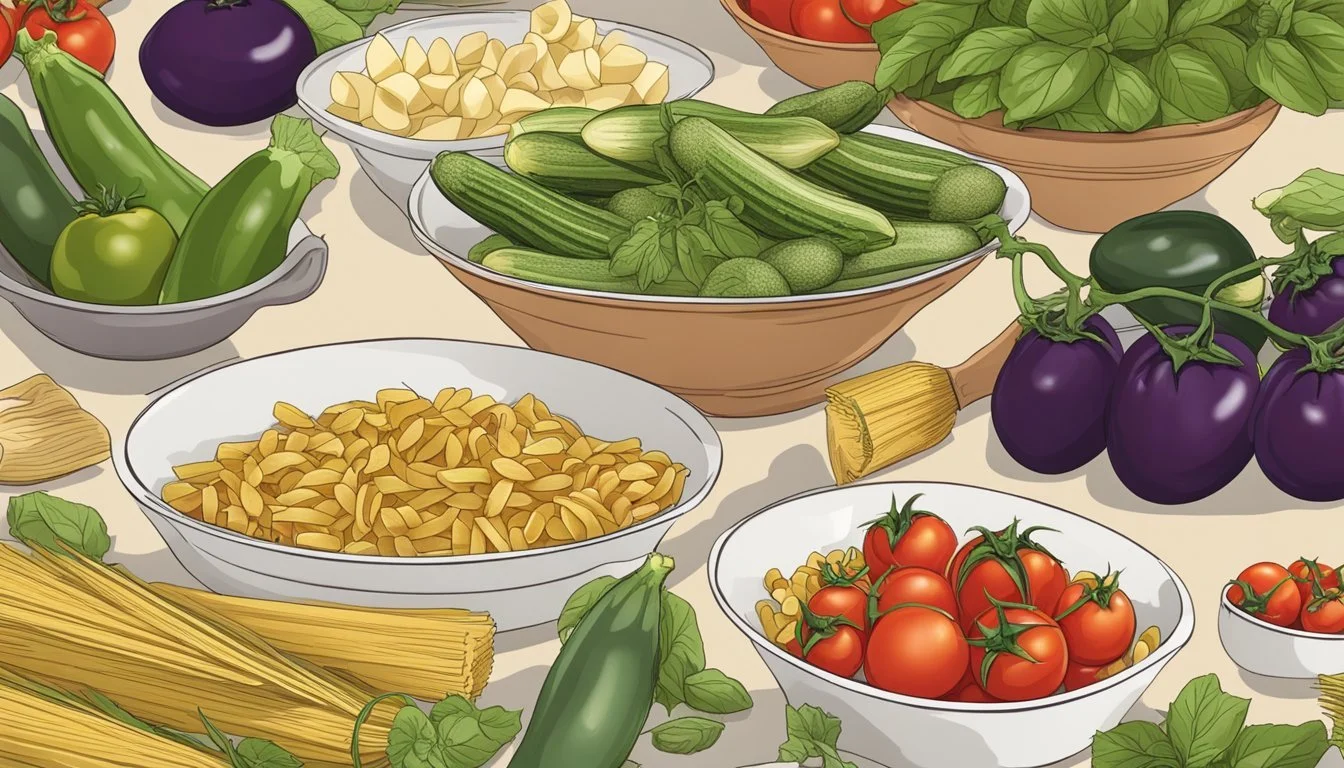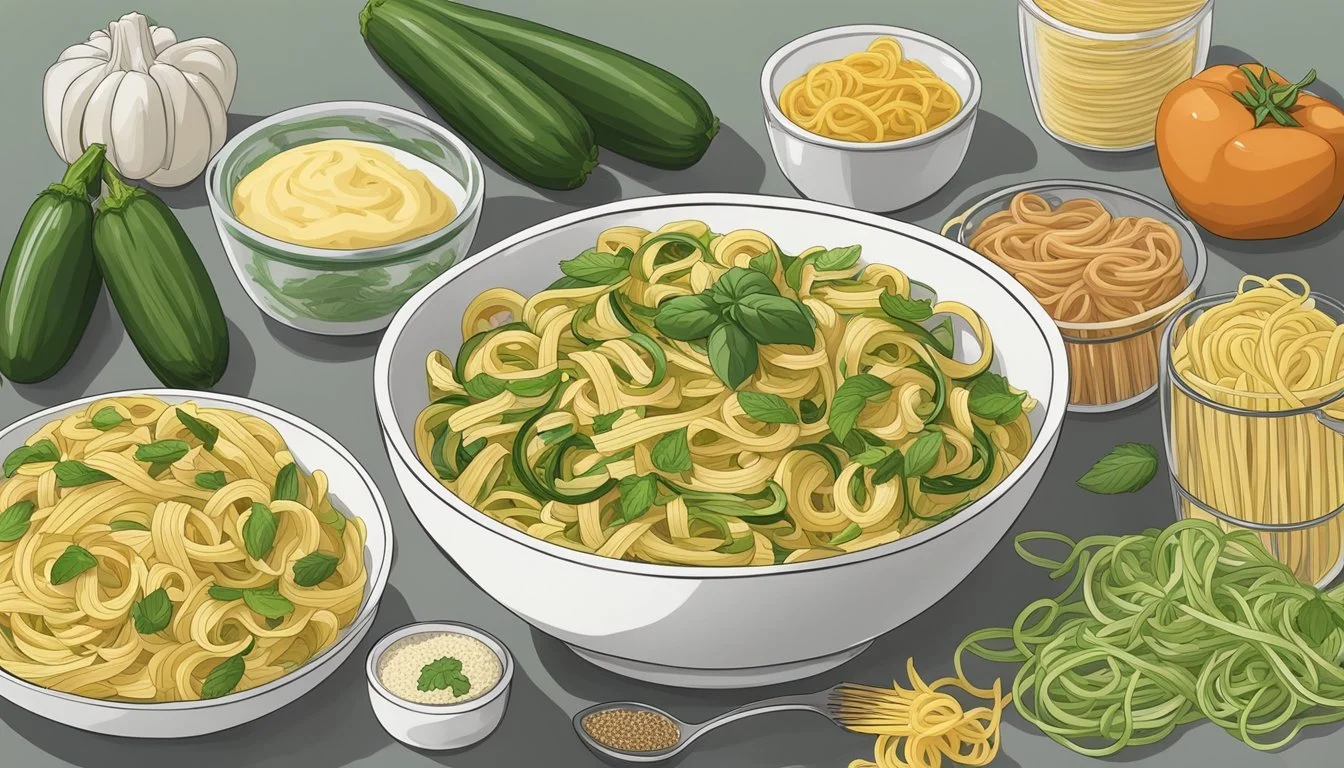Calamarata Pasta Substitutes
Top Alternatives for Your Dish
Calamarata pasta (What wine goes well with pasta?), a ring-shaped noodle inspired by calamari's circular form, adds a distinctive touch to any dish with its bold shape and ability to hold sauces. Its name and shape pay homage to the appearance of calamari rings, making it a staple in seafood dishes, particularly within Neapolitan cuisine. Traditional calamarata recipes often feature calamari sautéed alongside cherry tomatoes and white wine to create a flavorful and juicy sauce.
Finding the right substitute for calamarata pasta can enhance a variety of recipes, especially for those looking to explore beyond traditional pasta shapes or to accommodate dietary preferences. Substitutes such as king oyster mushrooms offer a seafood-like texture, and when flavored with sea-derived ingredients like dried seaweed and lemon, they can emulate the culinary experience of a seafood-based pasta dish.
When searching for alternatives, it's essential to consider the substitute's ability to complement the flavors and textures of the original recipe. The cooking method and timing might also vary with different pasta shapes or ingredients, but a successful substitute will maintain the essence of the dish. Through thoughtful selection, the integrity and intent of the original calamarata pasta dish can be retained, even when adjusted for different dietary needs or culinary exploration.
Understanding Calamarata Pasta
Calamarata pasta is a distinctive Italian pasta type named for its resemblance to calamari rings and known for both its unique texture and ability to hold sauces.
History and Origin
Calamarata pasta has its roots in Southern Italy, particularly from regions close to the sea, where seafood is abundant. The name "calamarata" reflects its resemblance to calamari or squid rings, which are often served with it.
Characteristics of Calamarata Pasta
Calamarata is a tubular pasta with a very wide ring shape and smooth texture, allowing it to hold hearty, chunky sauces. Its shape and large size make it ideal for seafood-based recipes, where it can mimic the shape and complement the texture of squid rings.
Nutritional Profile
Calories: A standard serving of calamarata provides a moderate amount of calories, ideally suited for an energy-rich meal.
Protein: As with most pasta, calamarata offers a substantial amount of protein, which can be increased further when paired with seafood or cheese.
Carbohydrates: Calamarata is high in carbohydrates, which provides the body with energy.
Fiber: Depending on whether it's made from refined or whole wheat flour, the fiber content can vary.
Iron & Potassium: It typically contains moderate amounts of iron and potassium, which can vary based on the type of grain used.
Nutrient Amount per serving Calories Variable Protein Variable Carbohydrates High Fiber Variable Iron Moderate Potassium Moderate
This section has provided an overview of calamarata's rich history, key characteristics, and nutritional content that make it a beloved choice for pasta enthusiasts.
Primary Calamarata Pasta Substitutes
When seeking alternatives to traditional calamarata pasta, one can turn to gluten-free, vegetable-based, or grain-based substitutes. These options cater to dietary restrictions and preferences, ensuring that the essence of the dish is maintained.
Gluten-Free Alternatives
For those avoiding gluten, a variety of gluten-free pasta alternatives are available:
Brown rice pasta: It offers a similar texture to traditional pasta while being entirely gluten-free.
Quinoa pasta: This substitute brings a nutty flavor and a dose of protein to the dish.
Black bean pasta: Black bean pasta stands out with its rich color and is a protein-packed gluten-free option.
Vegetable-Based Alternatives
Vegetable-based substitutes offer a low-carb, nutrient-dense choice:
Zucchini noodles: Also known as "zoodles," they provide a light and healthy twist to pasta dishes (What wine goes well with pasta dishes?).
Spiralized vegetables: Other vegetables like carrots or beets can be spiralized for diverse flavor profiles and textures.
Grain-Based Alternatives
Those seeking a whole-grain option can explore:
Whole wheat pasta: an option that mirrors the texture of traditional pasta with added fiber.
Spelt pasta: Spelt is an ancient grain with a chewy texture that holds up well in pasta dishes.
These substitutes ensure that the classic look and feel of calamarata pasta dishes are accessible to a wider audience, regardless of dietary needs.
Cooking Techniques and Considerations
When preparing Calamarata Pasta or its substitutes, achieving the desired texture, understanding the nuances of cooking times, and mastering flavor pairing are crucial.
Achieving Al Dente Texture
To obtain the sought-after al dente texture, one must cook pasta until it's tender but still firm to the bite. For Calamarata Pasta, this typically means boiling for about 2-3 minutes less than the package instructions to prevent overcooking.
Substitute Cooking Times
Different pasta shapes and sizes require varying cooking times. When substituting Calamarata:
Short, tubular shapes similar in size: Cook following the lower end of the suggested time range.
Longer, thicker varieties: May require additional time, typically several minutes more.
Refer to the substitute pasta's package for specific instructions, but maintain a watchful eye to avoid a mushy texture.
Flavor Pairing
Each pasta type carries flavors differently. Calamarata, with its ample surface area, is well-suited for:
Rich tomato sauces: They cling to the pasta, delivering a robust taste.
Seafood: Its texture and flavor complement Calamarata, especially when sautéed with ingredients like garlic and olive oil.
To retain the integrity of the dish when using substitutes, select ingredients that harmonize with the substitute pasta's characteristics.
Pasta Alternatives in Italian Cuisine
Italian cuisine is renowned for its diverse pasta dishes, but even within this tradition, there is room for innovation with pasta alternatives. Exploring these options can lead to new gastronomic experiences while maintaining the essence of Italian cooking.
Traditional Pasta Variations
In Italian cuisine, traditional pasta like spaghetti, fettuccine, and penne have established their place at the dinner table. Yet, there exist numerous lesser-known pasta shapes, such as Calamarata—ressembling sliced calamari rings—hailing mainly from the Neapolitan pasta tradition. These shapes are often specifically paired with certain sauces or ingredients to highlight their unique textures and flavors.
Variations within traditional pasta include:
Bucatini: A thick spaghetti-like pasta with a hole running through the center, perfect for clinging onto hearty sauces.
Orecchiette: Small ear-shaped pasta that acts as a scoop for chunkier condiments, commonly served with a vegetable-based sauce.
Incorporating Substitutes Into Italian Dishes
One can integrate pasta alternatives into Italian dishes while adhering to the foundational principles of the cuisine — the use of fresh, high-quality ingredients and the harmony of flavors. Vegetables transformed into noodle-like strands, commonly known as "zoodles," represent a popular low-carbohydrate alternative. Zucchini spirals are a versatile substitute that can seamlessly blend into an array of Italian dishes without compromising on taste or texture.
Utilizing grains such as quinoa, rice, and amaranth offers another dimension to traditional pasta. Quinoa spaghetti stands out as an alternative adding a subtle nutty flavor and a nutritious profile rich in protein and fiber. It pairs well with robust Italian sauces as much as traditional pasta does, providing a health-conscious twist to an authentic Italian meal.
Health and Dietary Benefits of Pasta Substitutes
Pasta substitutes offer significant health benefits, particularly for individuals seeking low-carb alternatives or aiming to increase their intake of dietary fiber and essential nutrients.
Low-Carb and Weight Loss Options
Calamarata pasta, with its tube-like shape and hearty texture, can be a delicious part of many dishes, but those monitoring their carbohydrate intake may seek alternatives. Low-carb pasta substitutes include options like spiralized vegetables (e.g., zucchini, carrots), shirataki noodles (made from the konjac plant), and legume-based pastas (e.g., chickpea or black bean pasta). These alternatives not only assist with weight loss efforts by providing fewer calories than traditional wheat pasta, but also help manage blood sugar levels, making them suitable for individuals with diabetes.
Spiralized Vegetables: Rich in vitamins, low in calories and carbs.
Shirataki Noodles: Almost zero carbs, very low calorie.
Legume-based Pastas: Higher in protein and fiber, lower in carbs than wheat pasta.
Nutrition and Dietary Fiber
In terms of nutrition, pasta substitutes made from whole grains, legumes, or vegetables offer a robust nutritional profile. They are often rich in dietary fiber, which aids in digestion and contributes to a sensation of fullness, potentially reducing overeating. Such pastas also provide a better balance of nutrients like protein, vitamins, and minerals.
Brown Rice Pasta: A source of vitamins and minerals, slightly higher in fiber.
Quinoa Pasta: Includes all nine essential amino acids, making it a complete protein.
Nutritional benefits of selected pasta substitutes:
Alternative Dietary Fiber (per serving) Notable Nutrients Legume-based Pasta High Protein, Iron, Folate Whole Grain Pasta Moderate B-Vitamins, Magnesium, Antioxidants Vegetable Noodles Variable Vitamin A, Vitamin C, Potassium
These pasta substitutes thus cater to a diversity of dietary needs while contributing to overall health and wellness.
Substitute Ingredients for Iconic Pasta Pairings
When experimenting with substitutes for Calamarata Pasta, it's essential to consider how these alternatives will harmonize with traditional pairings, such as sauces and proteins. Each substitute ingredient should complement the dish's existing flavors and textures.
Sauces and Seasonings
For Seafood Pasta:
Sauces: Use light sauces such as olive oil infused with garlic, lemon juice, and fresh parsley to accentuate the delicate flavors of seafood.
Herbs: Incorporate Italian spices, basil, and parsley to enhance the overall taste profile.
A table for quick reference on sauce pairing:
Substitute Pasta Sauce Suggestion Seasoning Zucchini Noodles Olive oil with garlic Parsley, lemon juice Whole Wheat Spaghetti Tomato-based Italian spices, basil Quinoa Pasta Butter with herbs Garlic, parsley
Protein and Vegetables
For Squid and Calamari Rings:
Texture Match: Choose pastas like _bucatini or _fusilli that mimic the texture and allow for the sauce and proteins to cling to the pasta. A dense grain like farro can also stand up well.
Cooking Method: Briefly cook in olive oil or butter to preserve the texture; mix with the pasta and sauce just before serving.
For a Medley of Vegetables:
Soft Vegetables: Cherry tomatoes and eggplant should be sautéed until just soft and combined with pasta alternatives such as spaghetti squash or shirataki noodles.
Crunchy Vegetables: Broccoli, when lightly steamed, pairs well with _whole grain pastas, allowing for a healthier and textured experience.
To summarize pairings with proteins and vegetables:
Protein/Vegetable Pasta Alternative Cooking Suggestion Calamari Rings Bucatini, Fusilli Sautéed in olive oil Cherry Tomatoes Spaghetti Squash Sautéed until soft Broccoli Whole Grain Pasta Lightly steamed
Preparation and Storage Tips
When substituting pasta in dishes, one must consider the nuances in texture, taste, and cooking times that different pasta shapes and types bring to a dish. This section provides guidance on proper storage and cooking techniques that ensure quality and flavor.
Storing Substitutes for Optimal Freshness
Dry Pasta: It should be kept in a cool, dry place in an airtight container. This prevents moisture from affecting the quality and prevents it from absorbing odors.
Fresh Pasta: It needs refrigeration and is best when consumed within one or two days.
Frozen Pasta: Can be stored in the freezer for up to three months. Avoid freeze-thaw cycles to maintain its texture.
Storage Tip: For leftover cooked pasta, one can store it in a sealed container with a small amount of olive oil or pasta water to prevent sticking and clumping.
Cooking Instructions for Best Results
Dry Pasta: Follow the package instructions for boiling times, but start checking for doneness a couple of minutes before the suggested time for an al dente texture.
Fresh Pasta: Usually cooks very quickly, often in less than five minutes, so it's crucial to monitor it closely.
Gluten-free or Alternative Grain Pasta: These might have different cooking times and water needs. Always refer to the packaging for specific instructions.
Cooking Tip: Reserve a cup of pasta water before draining cooked pasta. This starchy water can be used to adjust the consistency of the sauce it will be served with, enhancing the dish's overall texture and flavor.
Frequently Asked Questions
The FAQ section aims to clarify Calamarata pasta substitutions, providing precise measurements and addressing any common issues that may arise during the substitution process.
Substitution Ratios and Measurements
For those looking to substitute Calamarata pasta, understanding the correct ratios and measurements is essential to maintain the dish’s integrity. A standard rule is 1:1 substitution by volume, ensuring that the overall quantity of pasta remains the same. However, some substitutes might differ in density and cooking times. It is crucial to consider these factors to achieve the desired texture and flavor. For example:
Rigatoni: A suitable substitute due to its similar tube shape, use a 1:1 ratio.
Penne: While a different shape, penne can be substituted directly, also 1:1.
Substitutes like rice or grain alternatives may vary:
Brown rice pasta: Use 1 cup of cooked brown rice pasta for 1 cup of uncooked Calamarata.
Below is a quick reference table:
Substitute Measurement Notes Rigatoni 1:1 (by volume) Closest in shape and texture Penne 1:1 (by volume) Readily available alternative Brown rice pasta 1 cup cooked for 1 cup raw Watch for cooking time differences
Addressing Common Concerns
One may encounter several concerns when substituting Calamarata, such as texture differences or the ability of the pasta to hold sauce. Rigatoni holds sauce well and mimics the texture of Calamarata. Brown rice pasta offers a gluten-free option but may require a careful eye during cooking to prevent mushiness.
When substituting:
Ensure similar cooking times to avoid overcooking.
Pay attention to the sauce retention qualities of the substitute.
Consider dietary restrictions such as gluten intolerance when choosing a substitute like brown rice pasta.
By considering these factors, one can successfully substitute Calamarata while maintaining the spirit and enjoyment of the original dish.
Exploring Creative Pasta Alternatives
In the pursuit of dietary variety or specific nutrition goals, such as a low-carb diet, individuals often seek out pasta substitutes that maintain the essence of a dish while offering new textures and flavors.
Innovative Substitute Ideas
Zoodles: A popular choice for those on a gluten-free or low-carb diet, zoodles are made from zucchini spiraled into noodle-like strands. They can be cooked quickly and provide a versatile base for sauces, adapting easily to a range of recipes.
Spaghetti Squash: When cooked, the flesh of spaghetti squash separates into threads resembling spaghetti, hence the name. It’s a natural, nutrient-dense substitute for pasta, fitting well within a low-carbohydrate diet.
Shirataki Noodles: These translucent, gelatinous noodles are made from the konjac plant and are very low in calories and carbohydrates. Shirataki noodles are particularly suitable for Asian-style dishes.
Lentil Pasta: Pasta made from lentils offers a higher protein content compared to regular pasta and is a hearty alternative that stands up well in robust dishes.
Chickpea Pasta: Another protein-rich substitute, chickpea pasta brings a unique nutty flavor to the table and pairs well with a variety of sauces.
Hearts of Palm Pasta: Sourced from the core of palm trees, this type of pasta is low in carbs and has a texture that is reminiscent of traditional noodles.
When it comes to tools like the spiralizer, they open up possibilities to turn various vegetables into noodle-like shapes, offering a fun way to create a range of innovative pasta alternatives, including mezze maniche from vegetables.
Homemade Pasta Substitute Recipes
A spiralizer can transform zucchini into zoodles, an ideal substitute for mezze maniche in many pasta dishes. For best results, one should cook the zoodles until barely tender, which usually takes 1 to 2 minutes, and then drain them.
For a winter dish, one might roast spaghetti squash and shred it into noodle-like fibers. These can replace traditional forms of pasta in dishes that call for long strands, such as spaghetti or linguine.
Some pasta enthusiasts may experiment with homemade pasta dough using alternatives like chickpea flour or lentil flour. These can be shaped into various types of pasta like penne, fusilli, or even mezze maniche, catering to those on a special diet or looking for extra nutrition.








